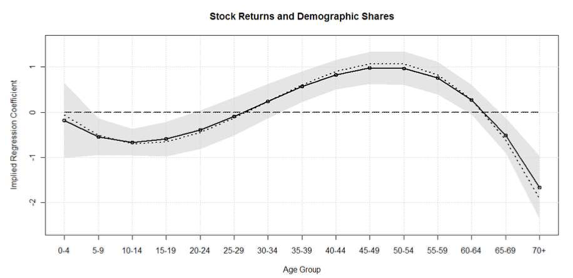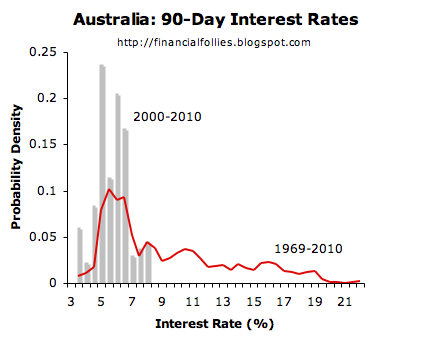
My MacroBusiness colleague The Prince has written at length on this site about some of the shortcomings of the “modern portfolio theory” (MPT) that still forms the basis of investing today. I have had this post stewing for a while, so at the risk of repeating some of the material already covered in The Prince’s excellent series on superannuation, I will proceed. Hopefully this will reinforce some of the ideas already covered on this site.
To quickly review, MPT makes some very questionable assumptions about market structure and investor behavior. To name just a few of the most fantastical ones:
- All investors behave rationally
- There is always sufficient liquidity and any investor can lend or borrow an unlimited amount at the risk-free rate
- There are no transaction costs
- Investment returns are normally distributed
Have you fallen out of your chair laughing yet?
To be fair to the investment community, there are very few people in the industry that actually believe in these assumptions, particularly after the crash of 2008. Nevertheless, many of the key elements of MPT still have a great influence on the way money is managed today. Perhaps most problematic is the assumption made under MPT that risk is equal to volatility.
What is Risk?
But before proceeding any further in this discussion, we should ask a simple question. What is “risk” when it comes to investing?
As The Prince stated in a recent post, risk is the unknown probability of an investor losing money.
However, this is not at all how risk is defined in the “modern portfolio theory” that still forms the basis for portfolio management today. Instead, the risk of a particular asset class is defined as the historical volatility (measured by the standard deviation) of its returns. There are a lot of problems with this definition of risk. Firstly, as investors we do not care about volatility on the upside–what keeps us awake at night is the risk of volatility on the downside. The theory, however, makes no such distinction. And that’s not the only problem. As any good value investor will tell you, often the greatest investment opportunities are to be had when volatility is high and other investors are panicking. Are equities less risky now than they were in late 2008, when the market was crashing? They’re certainly less volatile, but I would argue they are more risky.
Measuring risk based on historical volatility raises all kinds of other questions, too. For example, what is the relevant time period to examine? This is an important question, because savvy marketers of investment products will often pick and choose whatever period looks most favorable.
Let me give an example that should be closer to home for many of our readers. Many observers, from the IMF to Australian banks such as ANZ, have argued that the huge rises in Australian property prices over the past decade can largely be justified by what they describe as a “permanent” downshift in Australia’s nominal interest rates.
And what evidence do these analysts provide that this decline in interest rates is permanent? None whatsover, apart from the observation that rates have been historically low for a decade now. From this undeniable historical fact, they jump to the conclusion that the enormous rise in Australian household debt is not a problem, because interest rates are and always will be low. Nothing to worry about. But what if we look back further than just the last decade? The chart below shows the the past decade has been a huge historical outlier.
risk is present when future events occur with measurable probabilityuncertainty is present when the likelihood of future events is indefinite or incalculable
In other words, the standard theory assumes that all risks are measurable, and it attempts to calculate the probability of those risks based on historical precedent. But in the words of Donald Rumsfeld, perhaps what we should be more concerned about are the “unknown unknowns.”
There are known knowns. These are things we know that we know. There are known unknowns. That is to say, there are things that we know we don’t know. But there are also unknown unknowns. There are things we don’t know we don’t know.
The unknown unknowns are events that are by their very nature unpredictable. To take an extreme example, if the earth is wiped out by an asteroid tomorrow, it doesn’t really matter whether you own stocks or bonds. Now, in case you wonder where I am going with these philosophical meanderings, these concepts of risk and uncertainty are actually of great relevance to the way we invest.
Does Time Diversify Risk?
Standard investment theory says that time is a diversifier of risk. The longer your investment horizon is, the less risky, because any bad years will be ironed out by the long-term upwards trend. This is the classic “buy and hold” argument for equities. And the argument is not completely stupid. But it fails to take account of the distinction above between risk and uncertainty. In the words of the hedge fund guru Alexander Ineichen:
We believe time amplifies risk. It is true that the annual average rate of return has a smaller standard deviation for a longer time horizon. However, it is also true that the uncertainty compounds over a greater number of years. Unfortunately, this latter effect dominates in the sense that the total return becomes more uncertain the longer the investment horizon. The logic here is that over the longer term, more bad things can happen and the probability of failure (i.e., non-survival) is higher. The probability, for example, of San Francisco being wiped out by a large earthquake over the next 100 years is much larger than over the next 100 days. If accidents happen in the short term, one might not live long enough to experience the long term.
And now we return to the troublesome example of Japan.
Value investors have been pointing out for years that the Japanese stock market is cheap. Many stocks have been trading below book value for years. However, stocks (as well as everything else for that matter) only go up if the buyers are more powerful than the sellers. If there are no buyers, share prices do not rise, irrespective of their valuation or the “sentiment” among investors.
This lack of buying could be due to long-term changes in demography… Some ideas based on long-held beliefs simply might not work anymore if the regime—brought upon us through regulation or demographics or anything else—changes in a material way. As Keynes asked rhetorically: “When circumstances change, I change my view. What do you do?”Active risk management requires an open (and pragmatic) mind to “change”. So the whole idea of the equity risk premium and the idea that shares always go up in the long term could be regime specific, i.e. a function of population growth. Declining and aging populations (the “known”), potentially, could have an appetite for bonds, rather than stocks. Japan just could be a decade or two ahead of the curve in that regard; with the continuation and/or end of this trend being the “unknown”.
A recent paper titled Demographic Changes, Financial Markets and the Economy, lends weight to this argument. Based on a historical analysis of 22 country’s stockmarkets, you can see below that shares tend to do well when a large proportion of a country’s population is concentrated between the ages of 35-59. However, when people enter their 60s and retire, they tend to start selling off their assets, starting off with the riskiest ones, such as stocks and property. The Unconventional Economist has written about this concept with respect to housing prices. Exactly the same applies to equities. As populations age across the developed world, the demographic effect will start imparting a negative drag on the prices of risk assets like shares and house prices.

Such demographic factors are just one reason why (again, as pointed out by my fellow blogger The Prince), the so called “balanced” default option in most retirement funds (including Autralian super funds and US 401k plans) is actually extraordinarily risky — because it is making a very large bet that the equity premium in developed economies will be sustained over time.
So, am I suggesting that all investment theory is nonsense and that buy and hold investing is dead? No. But a smarter approach to asset allocation is needed. More in future posts. Suffice to say for now that it’s time to start questioning some of our assumptions about investment. They may not be serving us well.
Note: The views expressed in this post do not constitute investment advice. Please refer to the disclaimer in the menu bar above.
